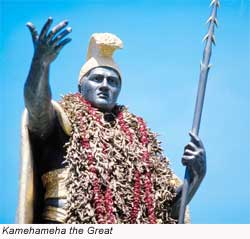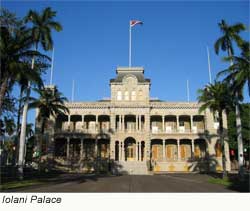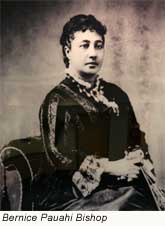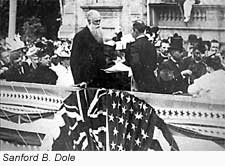 The Kingdom of Hawaii was established in 1810 upon the unification of the smaller independent chiefdoms of O‘Oahu, Maui, Molokai, Lānai and the Big Island of Hawaii through swift and bloody battles, led by a warrior chief who later would be immortalized as Kamehameha the Great. Kamehameha failed to secure a victory in Kauai, his effort hampered by a storm. Eventually, Kauai's chief swore allegiance to Kamehameha's rule. The unification ended the feudal society of the Hawaiian islands transforming it into a "modern", independent constitutional monarchy crafted in the tradition of European empires. The Kingdom of Hawaii was established in 1810 upon the unification of the smaller independent chiefdoms of O‘Oahu, Maui, Molokai, Lānai and the Big Island of Hawaii through swift and bloody battles, led by a warrior chief who later would be immortalized as Kamehameha the Great. Kamehameha failed to secure a victory in Kauai, his effort hampered by a storm. Eventually, Kauai's chief swore allegiance to Kamehameha's rule. The unification ended the feudal society of the Hawaiian islands transforming it into a "modern", independent constitutional monarchy crafted in the tradition of European empires.

Government in the Kingdom of Hawaii was transformed in phases, each phase created by the promulgation of the constitutions of 1840, 1852, 1864 and 1887. Each successive constitution can be seen as a decline in the power of the monarch in favor of popularly elected representative government. The head of state and head of government in the Kingdom of Hawaii was the monarch. He or she oversaw the Privy Council which was charged with administration. A royal cabinet, the Privy Council consisted of ministers in charge of departments much like that of the American system. These ministers also acted as the monarch's primary advisors.
 The 1840 Constitution created a bicameral parliament in charge of legislation. The two houses of the legislature were the House of Representatives (directly elected by popular vote) and the House of Nobles (appointed by the monarch with the advice of the Cabinet). The same constitution created a judiciary, charged with overseeing the courts and interpretation of laws. The Supreme Court was led by the Chief Justice, appointed by the monarch with the advice of the Cabinet. The 1840 Constitution created a bicameral parliament in charge of legislation. The two houses of the legislature were the House of Representatives (directly elected by popular vote) and the House of Nobles (appointed by the monarch with the advice of the Cabinet). The same constitution created a judiciary, charged with overseeing the courts and interpretation of laws. The Supreme Court was led by the Chief Justice, appointed by the monarch with the advice of the Cabinet.
The islands of Hawaii were divided into smaller administrative divisions: Kauai, Oahu, Maui, and Hawaii. Kauai region included Niihau, while Maui region included Kahoolawe, Lānai and Molokai. Each administrative region was governed by a governor appointed by the monarch.
From 1810 to 1893, the Kingdom of Hawaii would be ruled by two major dynastic families, the Kamehameha Dynasty and the Kalākaua Dynasty. Five members of the Kamehameha family would lead the government as its king. Two of them were direct sons of Kamehameha the Great himself. They were Liholiho (Kamehameha II) and Kauikeaouli (Kamehameha III). For a period between Liholiho and Kauikeaouli's reigns, Kamehameha the Great's primary wife, Queen Kaahumanu, would rule as Queen Regent and Kuhina Nui, or Prime Minister.
 Dynastic rule by the Kamehameha family tragically ended in 1872 with the death of Lot (Kamehameha V). Upon his deathbed, he summoned Princess Bernice Pauahi Bishop to declare his intentions of making her heir to the throne. She was the last direct Kamehameha family member surviving. She refused the crown and throne in favor of a private life with her husband, Charles Reed Bishop. Lot died before naming an alternative heir. Dynastic rule by the Kamehameha family tragically ended in 1872 with the death of Lot (Kamehameha V). Upon his deathbed, he summoned Princess Bernice Pauahi Bishop to declare his intentions of making her heir to the throne. She was the last direct Kamehameha family member surviving. She refused the crown and throne in favor of a private life with her husband, Charles Reed Bishop. Lot died before naming an alternative heir.
The refusal of Princess Bernice Pauahi Bishop to take the crown and throne as Queen of Hawaii forced the legislature of the Kingdom to declare an election to fill the royal vacancy. From 1872 to 1873, several distant relatives of the Kamehameha line were nominated. In a popular vote, William C. Lunalilo became Hawaii's first of two elected monarchs.
Like his predecessor, Lunalilo failed to name an heir to the throne. He died unexpectedly after less than a year as King of Hawaii. Once again, the legislature of the Kingdom of Hawaii was forced to declare an election to fill the royal vacancy. Queen Emma, widow of Kamehameha IV, was nominated along with David Kalākaua. The 1874 election was opined to be one of the nastiest political campaign seasons ever in Hawaii history. Both candidates resorted to mudslinging and rumors. David Kalākaua was elected the second elected King of Hawaii.
Hoping to avoid uncertainty in the monarchy's future, Kalākaua proclaimed several heirs to the throne and defined a royal line of succession. His sister Liliuokalani would succeed the throne upon Kalākaua's death. It was indicated that Princess Victoria Ka‘iulani would follow. If she could not produce an heir by birth, Prince Jonah Kūhiō Kalanianaole would rule after her.
Queen Liliuokalani inherited a monarchy that was left impotent by her brother's Bayonet Constitution of 1887. David Kalākaua's Royal Cabinet forced him at gunpoint to sign the constitution stripping the monarchy of much of its power in favor of an administration controlled by Americans. The constitution was the opening salvo to the end of the Kingdom of Hawaii.
 In 1893, American businessmen seeking to protect their industrial profits in the exportation of goods like sugar to the United States of America organized the overthrow of the Kingdom of Hawaii. American troops aboard the USS Boston landed in Honolulu to help Sanford B. Dole and Lorrin A. Thurston's Committee of Safety, a 13 member council of businessmen plotting to depose Queen Liliuokalani. At the gunpoint of American soldiers, Queen Liliuokalani was removed from ‘Iolani Palace under arrest, tried by the American Judge Advocate General's Corps and then imprisoned in her own home. In 1893, American businessmen seeking to protect their industrial profits in the exportation of goods like sugar to the United States of America organized the overthrow of the Kingdom of Hawaii. American troops aboard the USS Boston landed in Honolulu to help Sanford B. Dole and Lorrin A. Thurston's Committee of Safety, a 13 member council of businessmen plotting to depose Queen Liliuokalani. At the gunpoint of American soldiers, Queen Liliuokalani was removed from ‘Iolani Palace under arrest, tried by the American Judge Advocate General's Corps and then imprisoned in her own home.
Dole and his committee declared itself the provisional government and proclaimed the creation of the Republic of Hawaii. Dole became its president. As a republic, it was the intention of the provisional government to campaign for annexation with the United States of America. With annexation, their goods and services exported to the mainland would not be subject to American tariffs. The provisional government succeeded when in 1897, Congress approved the Treaty of Annexation creating the U.S. Territory of Hawaii. Dole was appointed its first governor.
Early in its history, the Kingdom of Hawaii‘i was governed from several locations including coastal towns on the islands of Hawaii and Maui (Lahaina). It wasn't until the reign of Kamehameha III that a capital was established in Honolulu on the Island of Oahu.
|